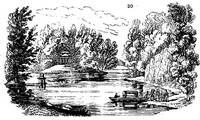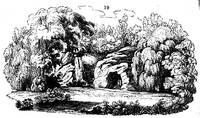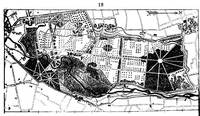106.Most of the villas in Lombardy, which we visited in 1819, were too much ornamented, and too full of walks, seats, arbours, and other ornaments, for that repose and simplicity which, according to our ideas, is essential to an English garden. Art, in most of these gardens, is as much avowed as in the French style; whereas, in the true English garden, though art is employed, yet it is not avowedly and ostentatiously displayed; on the contrary, the grand object is to follow the directions of the Italians themselves, and study that the art �che tutto fa, nullo si scopre.� The first introduction of foreign trees and shrubs into Lombardy took place about the year 1770, when a taste for ornamental gardening in the natural or English style first began to prevail. The first English gardens, as they were called in Lombardy, were those laid out by the brothers Pecinardi near Cremona. The plan of these gardens being in imitation of nature, it became necessary, when it was wished to orna-ment them, to plant them with trees and shrubs that were different from those around them; and this led to the introduction of foreign plants, those, of course, being preferred which were most various in their foliage and in the colour of their flowers. The next ornamental gardens that were planted in Lombardy were those of the brothers Zappa, who were Dutch merchants, and who introduced a great number of hardy trees and shrubs from Holland. Those were followed by the gardens of the Marquess Cusani al Dasio, those of the Villa Mallerio in Brianca, and those of the Villa Litta al Lainate. The most remarkable gardens of Lombardy are, however, those of Monza, and of the Isola Bella. A short account of all these gardens will be given below. Villa Traversi al Desio. There are several ornamental villas at Desio, a village celebrated for its peaches, and lying about four leagues north of Milan; but the most beautiful of these villas is the one formerly called the La Cusani, but which is now known as the Villa Traversi al Desio, having become the property of Signor Traversi. This villa was laid out by the Marquess Ferdinando Cusani in 1777, when a taste for English gardens was first becoming general in Lombardy; and it is supposed that the Marquess ruined himself with this garden, as it was offered for sale immediately after his death. The garden is very tastefully laid out, and as the ground is naturally flat, the elevations of the soil must have been made by art, and consequently have cost a great deal. Besides the ground being well laid out, the trees are planted and grouped with great judgment; and none of them are placed at random, which is generally the case when such a trust is confided to the care of those who are inexperienced, or who have not studied nature. Here, on the contrary, the gradations of the different colours of the foliage are so displayed as to afford abundant sources of variety and pleasure. In short, the eye continually wanders from one beauty to another, and particularly so around the lake. There is no profusion of buildings or ornaments, which, when crowded together in a garden without any attention being paid to situation or suitableness, rather fatigue than enliven the spectator. There are, however, some very elegant buildings. and among others a small temple, in which there is a statue of Hymen, and a small building adjoining dedicated to Tasso, and ornamented with fresco paintings, the subjects of which are taken from his works. The mansion is magnificent, and contains a spacious gallery of paintings. The fault, however, is, that it is too large in proportion to the garden. In the garden are some magnificent specimens of Magnolia and other foreign trees; and in the flower houses upwards of five hundred kinds of Camellia. The Villa Mallerio al Gernetto is in Brianca. It is beautifully situated, and has a favourable soil and delightful climate: the park is, in fact, a true English garden, and it occupies a fertile valley of consider-able extent, through which runs the river Lambro. The slopes exposed to the west are laid out in terrace gardens called in Italy the Genoese style. The view from these terraces is most maginificent. Among the splendid trees in this park may be mentioned a Melia Azedarach, 40 ft. high, with a trunk 4 ft. in circumference, several camellias 12 ft. high, and numerous specimens of Eucalyptus, Clethra arbdrea and Rhododendron arbdreum. Count Giacomo Mallerio, the proprietor of this place, was the first to introduce the camellia and the tree p�ony into Italy. The Villa Silva, at Cinisello, was the summer residence of the Count Silva, who translated Hirschfeld's work on Gardens. The villa, which was laid out in 1797, is very extensive, and it is well planted with groups of trees, which are mingled with busts of celebrated men, temples, thatched cottages, &c. The scene, however, wants water. The Villa Litta al Lainate is laid out partly in the French style, and partly as an English garden. This villa is celebrated for its grottoes; and there are fountains and water-works, which, from their great variety, must have cost an immense sum. The floors and great part of the walls of these grottoes are inlaid with mosaic work, and small flints of various colours, ingeniously put together, and arranged with taste; the other parts of the walls are covered with a calcareous tuffa, all of which gives a good idea of a real grotto. The extent and beauty of the gardens of the Isola Bella (fig. 17.) have been greatly exaggerated by Eustace and other travellers. �Nothing,� says Wilson, �can be so noble as the conversion of a barren rock, without an inch of earth on its surface, into a paradise of fertility and luxury. This rock, in 1640 produced nothing but mosses and lichens; when Vitaliano Borromeo conceived the idea of turning it into a garden of fruits and flowers. For this purpose, he brought earth from the banks of the lake, and built ten terraces on arches, one above the other, to the top of the island, on which the palace is placed. This labour has produced a most singular pyramid of exotics and other plants, which make a fine show, and constitute the chief ornament of this miracle of artificial beauty (fig. 16.). The orange and lemon trees are in great luxuriance, and the grove of bays (L. nobilis) is hardly to be equalled any where in Europe; two of them, in particular, are said to be the largest known in existence.� (James Wilson's Journal of Two successive Tours on the Continent, 3 vols. 8vo, vol.iii. p.449.) Many travellers imagine that the orange trees in the Isola Bella, and on the shores of the Lago Maggiore and other lakes, stand the winter without protection, because they are planted in the open ground. But the truth is, that these trees are regularly defended in winter by temporary sheds of wood or straw, or both; and in extremely severe weather have even artificial heat. The beauties of the Isola Bella have been differently estimated by different travellers. A French author writes: �'L'Isola Bella est digne de son nom: elle ressemble a une ile enchantee; palais n erveilleux, magnifiques jardins, arbres odoriferans, fontaines cristallines, statues, bosquets, fleurs choisies; tout s'y trouve.� Galiffe says, �the Isola Bella is altogether artificial, and contains a large but ill-looking palace in the worst taste of architecture, with a pyramid of terraces and flower-gardens raised one above another There is no shade, except in one place near the margin of the lake, where some very fine laurel trees (L. nobilis) grow; on one of which Bonaparte's name was carved, it is said by himself, on his way to or from Marengo.� (Italy and its Inhabitants in 1817.) Mr. Hazlitt was �utterly disappointed in the Borromean Isles.� �Isola Bella,� he says, �resembles a pyramid of sweetmeats ornamented with green festoons and flowers.� (p. 368.) Brockenden says, the Isola Bella �is only worthy of a rich man's misplaced extravagance, and the taste of a confectioner.� (Illustrations of the Passes of the Alps, &c., 1828.) The statue of St. Charles Borromeo is very striking. �On a hill above Arona, a very picturesque little place, near the Borromean Isles,� says Wood, �is the statue of St. Charles Borromeo; sixty-six feet high, on a pedestal of above thirty; so that the whole is about one hundred English feet in height. As I walked along the road below, the pedestal was quite lost; and the great priest walking among the woods, which reach only to his middle, and holding up his fingers in the act of blessing the people, had a very singular effect. The statue is made partly of cast bronze, and partly of plates of copper on timber framing; and the execution is very good. The views from it are exceedingly fine.� (Wood's Letters, &c., vol. i.) At Monza, the royal residence, near Milan, is the finest garden scenery in Italy. The park contains upwards of 3000 acres, of a gently varied, fertile surface. It is chiefly laid out in the regular style; but contains also an English garden of considerable extent and beauty. It is well watered, and the walks are not so numerous as to disturb the unity and repose of the scene. The culinary, flower, botanic, and fruit gardens, orangeries, and hot-houses, are all good, and well managed. Very fine avenues lead from this residence to Milan. The whole was greatly enlarged and improved in Beauharnois's time, under the direction of the late Signor Villoresi, one of the most scientific gardeners in Italy; and was managed by him till his death in 1823. A plan of the park of Monza (fig. 18.), with a description, and views of the palace and gardens, was published in 1827. Its chief features appear to be in the ancient style: but that portion of it which is laid out in the English manner (a) contains some interesting views, particularly a grotto scene, and the island in the lakes (figs. 19. and 20.). The river Lambro (fig. 18. b), which passes through the grounds, adds greatly to their interest in a picturesque point of view; and is, at the same time, employed for irrigating part of the park. The palace (c), finished in 1780 by Piermarini, is a large building (fig. 21.); but loses much of its effect as a country residence from being placed at one corner of the grounds, and near to the town of Monza (fig. 18. d). The double avenue to Milan (e) is composed of tulip trees, magnolias, melias, robinias. and other flowering trees, interspersed with evergreen and American oaks, and has a very beautiful effect both in summer and autumn, and even in winter, from the number of evergreens. (Promenade dans le Parc de Monza, par F. Lose. 12mo, Milan, 1827.) These trees, which were mostly planted in 1808, have now attained a very large size, particularly some cedars of Lebanon, and some of the magnolias. There is, indeed, a shrubbery composed entirely of Magnolia grandiflora, some specimens of which have attained a great height. The botanic garden, which is close to the house, contains a numerous collection from every part of the world. The hot-houses are very numerous, and are also placed close to the house: besides plants of ornament, they contain an immense quantity of orange and lemon trees, and pine-apples. In the park there are a great many enclosures, some of which are arable, and others are vineyards or orchards. There are a number of ornamental cottages occupied by peasants ; and in the garden there is a tower appropriated to a collection of crypto-gamous plants, and other subjects of natural history, modelled in wax. In 1843, two new stoves were erected, and a botanic garden, for perennial exotics alone, was laid out.











